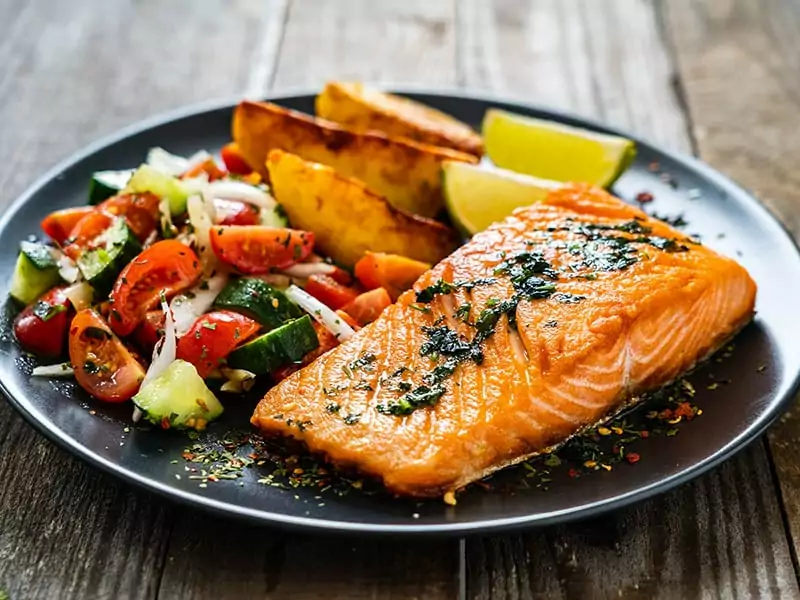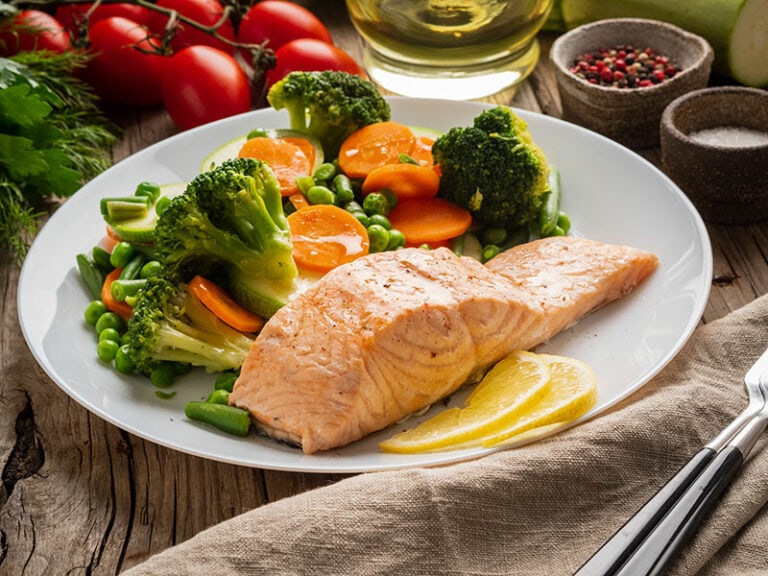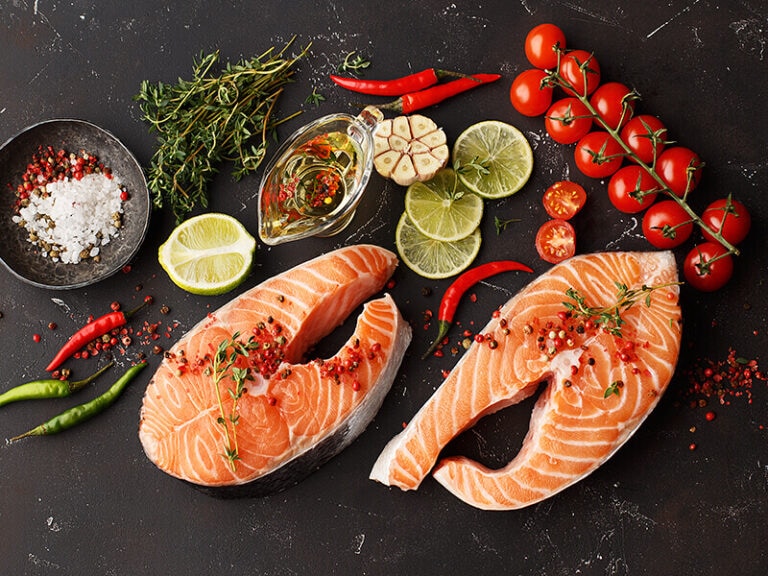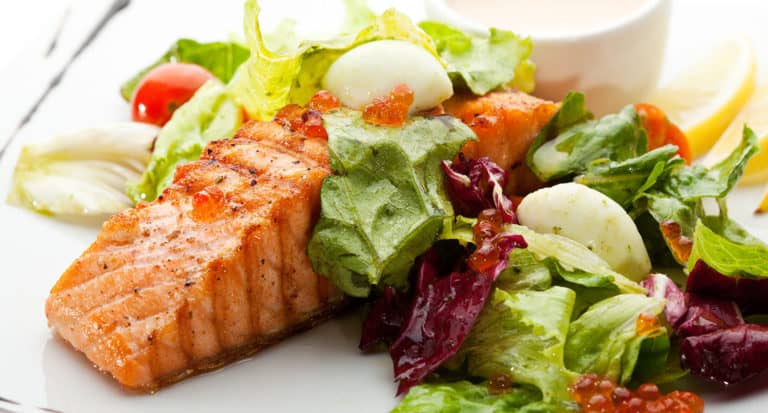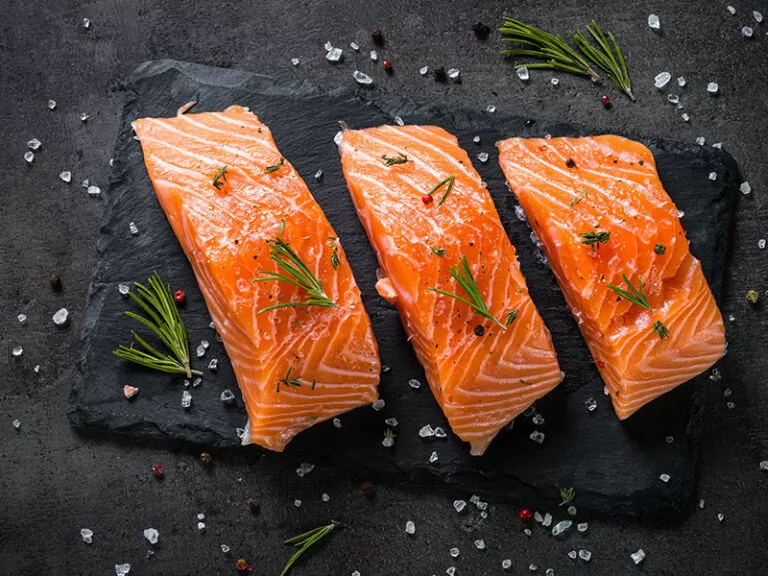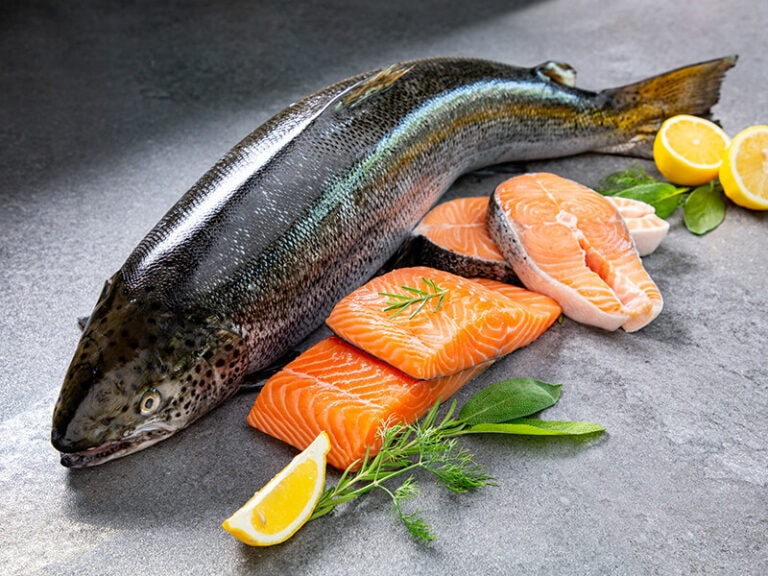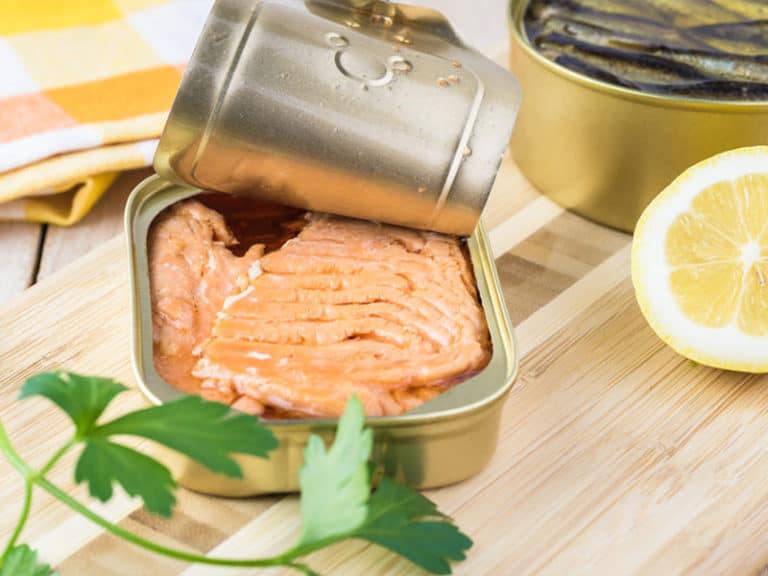How long to bake salmon at 375°F (190°C)? You have your piece of salmon filet ready in the refrigerator, and your oven is already heated. What makes you still feel anxious is the time. How long will it take for your salmon to be perfectly cooked?
Baked salmon is a classic family dinner dish, and baking salmon will not just be about time and heat. You need to learn about salmon dressing, which spices will compliment it, and what you should avoid. Therefore, I will stop rambling and start to show you what you want to learn.
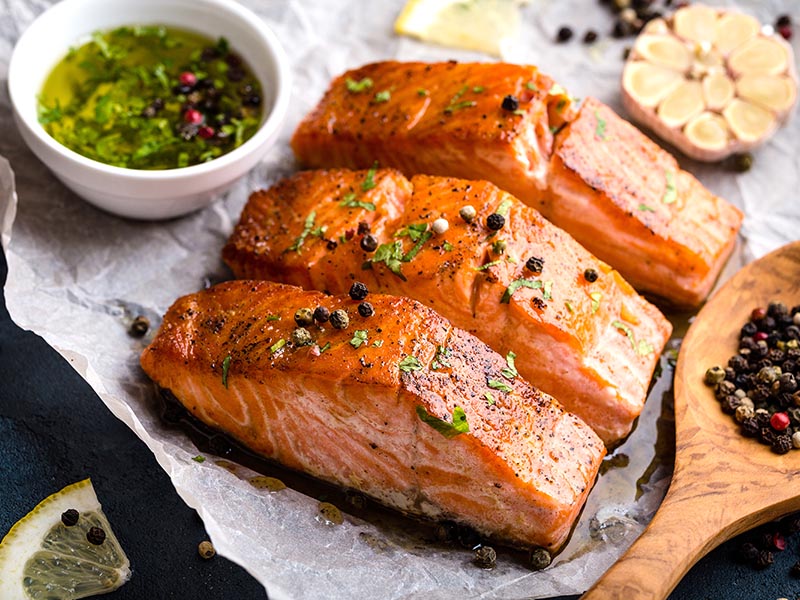
Nutrition Facts Of Baked Salmon And What To Expect In Baking Salmon At 375°F
When people talk about salmon, they mention how rich in protein and omega-3 a salmon can be. This type of fish is also good for elders and pregnant women due to its nutrient content.
Consuming the right amount of salmon per person can prevent your body from developing cardiovascular diseases and thyroid diseases. Furthermore, its fatty acids enhance people’s brains. Children can develop better cognitive function if they eat salmon regularly. (1)
With its benefits, salmon can help people with their mental health. Salmon improves your psych and lowers the severity of dementia and depression. ADHD patients are also recommended to eat salmon to reduce the symptoms.
However, having too much salmon causes you some critical complications as well. One of the modern world’s problems with fish is the traces of methylmercury in their flesh. Ingesting too much methylmercury will lead to mercury poisoning.
The jeopardies of salmon don’t just stop there. Too much salmon in your meal will also be bad for your blood coagulation. If you have bleeding problems or currently have an injury, it is not fine to eat this natural blood thinner.
One of the matters that I want to address is “why at 375°F?” This temperature is ideal for cooking many different types of meat, not just salmon.
For example, once you’ve mastered the perfect timing for baking chicken wings at 375, your meal will be delicious every time. Likewise, baking salmon at 375°F will give you the result of crispy brown color on top and tender meat underneath.
Sometimes, people try to bake salmon at 350°F or 400°F. The result turns out to be overcooked or too dry. Even though it takes less time to bake salmon at 450°F, your salmon will be cooked evenly at 375°F. Therefore, 375°F is better to get the perfect baked salmon.
There are many health benefits from consuming salmon that you should learn.
How Long To Bake Different Types Of Salmon At 375°F
This is time you reach the golden answer to today’s question. I will give you the solutions for all types of salmon you might have. Frozen salmon, a whole salmon, salmon in foil, etc. You name it!
One of the notes that I should mention is that all the time in this section excludes the preheat time for your oven. Preheating the oven to 375°F will take you about 15-20 minutes.
Salmon Filet
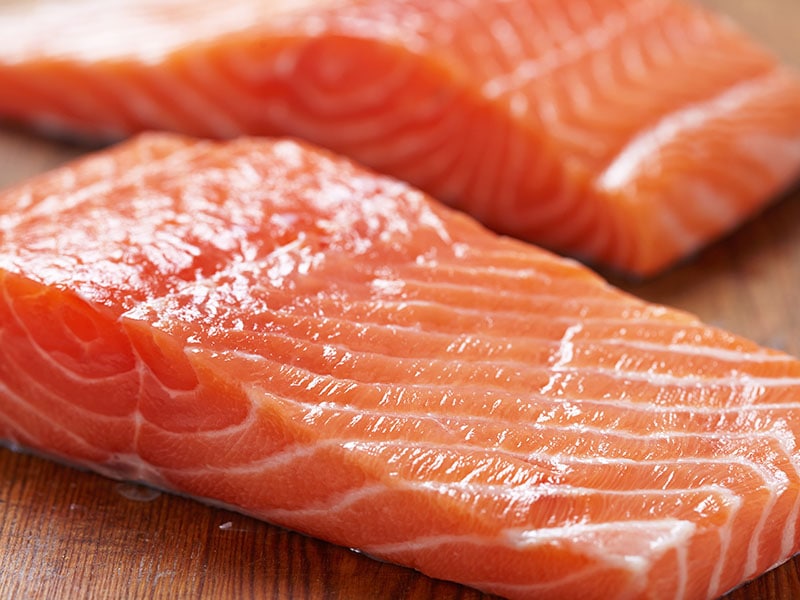
Salmon filets can have various sizes and thicknesses. However, we usually see a typical salmon filet weight 5-7 ounces (140-200 grams). This is a perfect size for a one-person meal. With this small portion, you can cook in 14-17 minutes.
The outcome should have a layer of brown skin on top. If you leave the salmon skin on, that skin will turn crispy. Alternatively, you can also bake salmon filets at 350°F, but that requires a bit more time.
With Foil/ Parchment Paper
Some people prefer to bake their food in foil since they believe the foil will trap the heat and the water evaporation inside. Therefore, their food can keep its moisture and turns out tender.
The drawback of using foil is its need for a longer cooking time. Since the foil pocket traps all the water inside, it takes you a little more time to cook your salmon, and sometimes you might overcook your salmon. Foiled salmon takes 15-20 minutes to be perfectly cooked.
In case your salmon in foil is undercooked but you have already opened the cover, you can just rewrap the foil around the salmon, and let your fish cook for another while.
A Whole Salmon
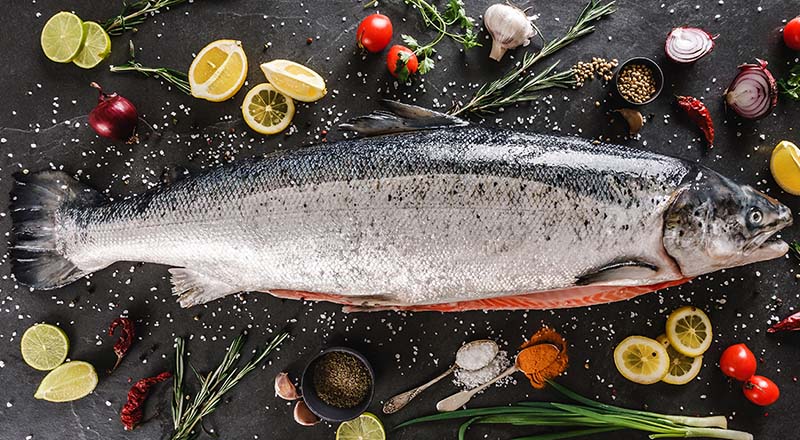
So you’re going to have a big gathering, like a housewarming party or something like that, and you decide to treat your guests with baked salmon. A big salmon on your dining table would be extremely impressive. But how long will it take for a whole salmon to be cooked?
With a huge food like a whole salmon, you will need more time compared to a filet. At the temperature of 375°F, you will need 35-40 minutes.
And you need to check the internal temperature of the salmon inner heat carefully as well. 160°F is the number that you want to see.
Usually, people can use a fork or a long needle to check salmon’s tenderness. However, in the case of a big salmon, an instant-read thermometer will be handier. After all, you don’t want to serve your guests baked salmon and salmon sushi at the same dinner, right?
Frozen Salmon
You will need to thaw your frozen salmon before you want to season it and cook it. You can defrost your salmon filet in the refrigerator. After 12-18 hours, your filet should be ready to cook. Or you can cover your salmon in a bag of plastic and submerge it in water.
After thawing, you can bake it like it’s a regular salmon filet. But in case you don’t have time to thaw the fish, you can bake your salmon right away. This will take you 30-40 minutes to cook it.
Frozen salmon will promise you a moist outcome. However, because your salmon is cold, it can turn out undercooked inside. You will need the thermometer for this case to make sure the inner part is at 145°F.
Marinated Salmon
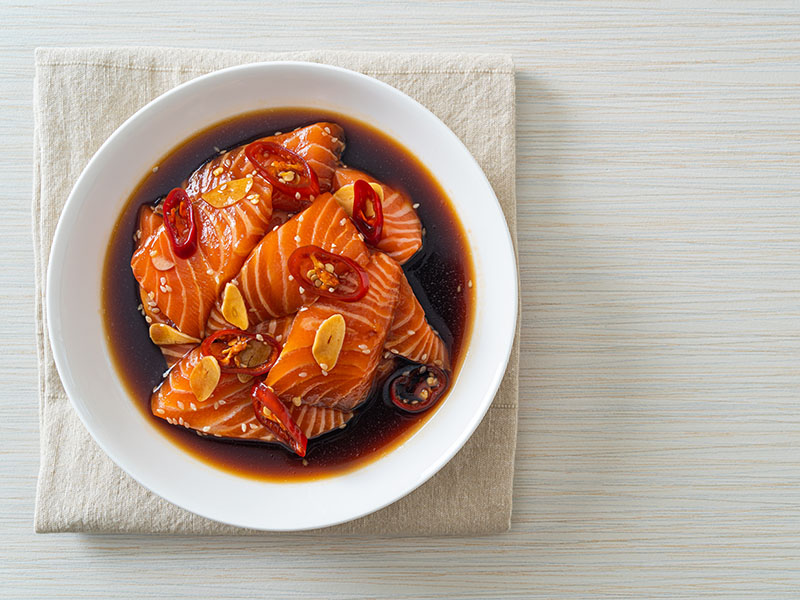
Marinating your salmon will enhance its flavor, but it will not overwhelm the amazing taste of salmon. To marinate your salmon, you will need to cover your salmon with the sauce. Your salmon will need a certain amount of time for the sauce to penetrate inside the meat.
The ideal marinating time for salmon will differ depending on its size, texture, and other factors. After marinating, your salmon tends to be very tender and soft. You will not need too much time to cook it. Depending on the recipe, your salmon requires 10-13 minutes to be cooked.
There are plentiful ways to marinate your salmon. Here are 5 marinades that you can try.
Ingredients That You Will Need Besides Salmon
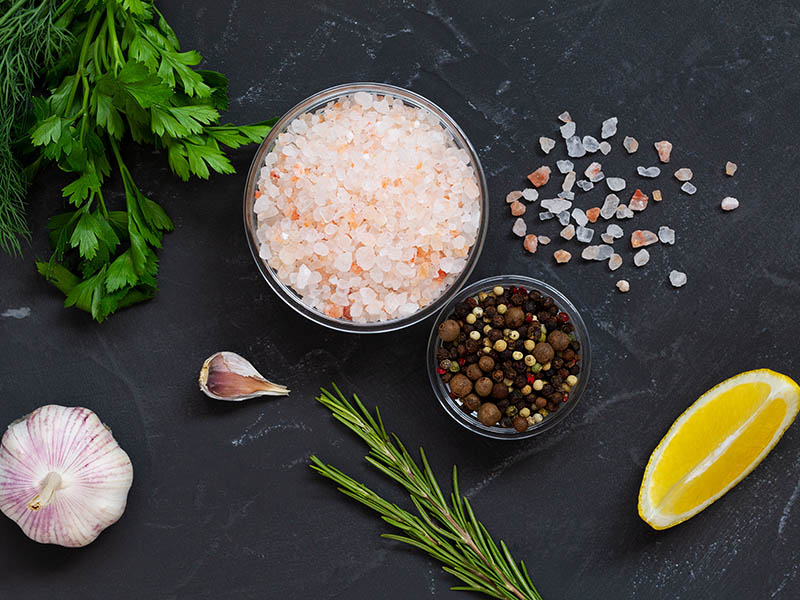
Baking salmon is not a difficult mission that needs all the condiments and spices in the world. Baked salmon is a simple dish that can be made with any ingredients that you crave, but in this recipe, you will only need six more ingredients besides the salmon itself.
The list below is enough to cook a 5-ounce (140g) piece of salmon filet:
- Four tablespoons of lemon juice or a whole lemon
- 2 tablespoons of unsalted butter so you can control the salt intake.
- Two teaspoons of minced garlic
- ½ teaspoon of salt
- ½ teaspoon of black pepper
- A tablespoon of chopped dills
These ingredients look simple, but they are excellent at highlighting the tenderness and sweetness of salmon. It is a combination of sour flavor from lemon, creamy taste from butter, pungency from garlic, a hint of spicy and salty, and lastly, the fresh herb aroma from dill.
You can customize your seasoning. The flavor depends on you. If you like your salmon to be sweeter, you can use honey. If you prefer a smoky flavor, you can add smoked paprika or cumin. The world is your oyster, after all.
How To Bake Salmon Filet At 375°F?
So you have prepared all the ingredients and finished all the pre-work, it’s time for your culinary skills to shine. You can choose one of these below equipment to bake your salmon.
Oven
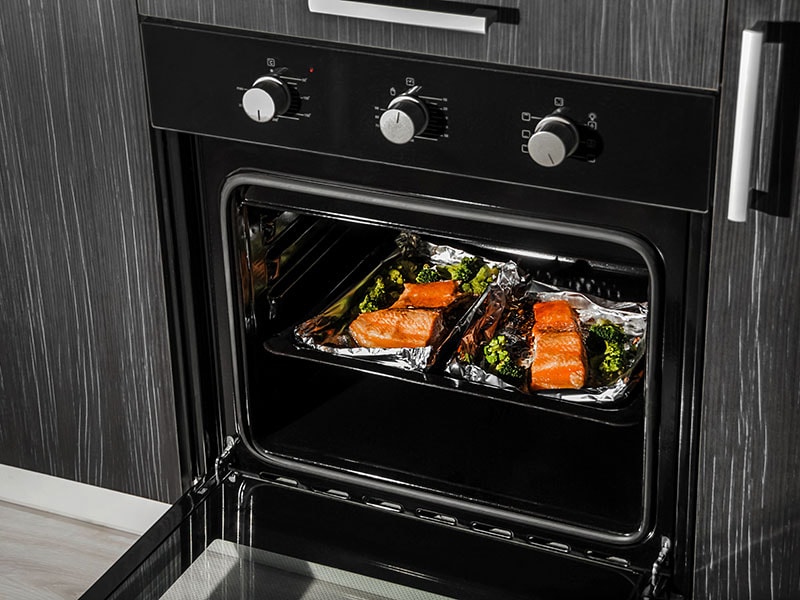
One filet is enough to serve one person. The recipe that I introduce after this will be used for the ingredients that I have listed above with a 5-ounce piece of salmon filet.
Step 1: Preheat Your Oven
Many forget about this step, and their salmon turns out undercooked or extremely dry most of the time. When you own the oven, you need to preheat it every time you want to use it. To bake salmon, you will want to turn your oven on at 375°F for 15 minutes.
Step 2: Season The Filet
While waiting for your oven to be ready, you should prepare your seasoning. You can start by covering your pan inside the surface with foil. This will prevent your salmon from sticking to your pan later. Coat a layer of vegetable oil on that foil.
Then, you can put your filet in the pan with the skin side facing down. This doesn’t matter if you have removed your salmon skin beforehand.
All the other ingredients, you mix them together, then spread that season liquid on your salmon filet. Wait about 1-2 minutes before putting your pan inside the preheated oven.
Step 3: Turn On The Oven Again
Allow your oven to cook your filet at 375°F for the first 15 minutes. After that, you change your oven setting to broiling (heat from above only) and let the oven cook for another 5 minutes. This move will allow your filet to develop appetizing golden to brown colors.
When the cooking is done, you should check the internal temperature again. If the thermometer shows 140-150°F, then congratulations, your salmon is perfectly baked. You can decorate your salmon with parsley and dills or with sauce like peso.
Air Fryer
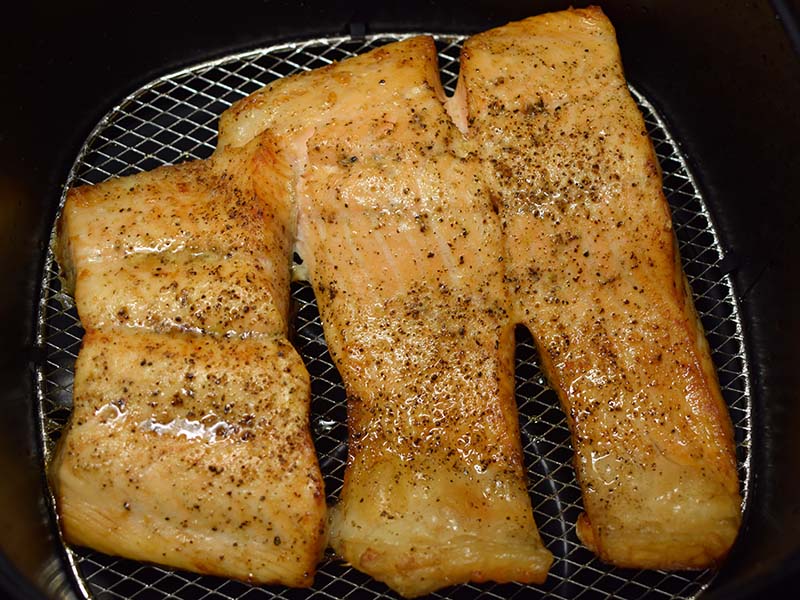
The air fryer is a modern, useful kitchen equipment. It has only been around for several years, but its usefulness has been recognized by many household cooks and professional chefs. And you can use it to turn your salmon into a yummy keto-friendly air fryer dish.
The procedure is almost the same with the oven, except that the air fryer takes a shorter time to bake salmon.
Step 1: Preheat The Air Fryer
At the temperature of 375°F, you will need 5 minutes for the air fryer to preheat itself.
Step 2: Dress Your Filet With Seasoning
The seasoning is the same for this method with the air fryer; you don’t have to cover the air fryer with the foil. You can use vegetable oil or cooking spray on the surface of the air fryer’s basket.
You should season your filet before putting it in the air fryer when the machine is ready.
Step 3: Bake Your Filet
Turn the air fryer on again and let it cook your fish for 12 minutes. You don’t have to flip your salmon this time since the air fryer bakes your salmon with the air inside the machine.
When your salmon is ready, it will have a beautiful brown color outside. The air fryer keeps your fish moist and extremely tender.
How To Tell If Your Salmon Is Done
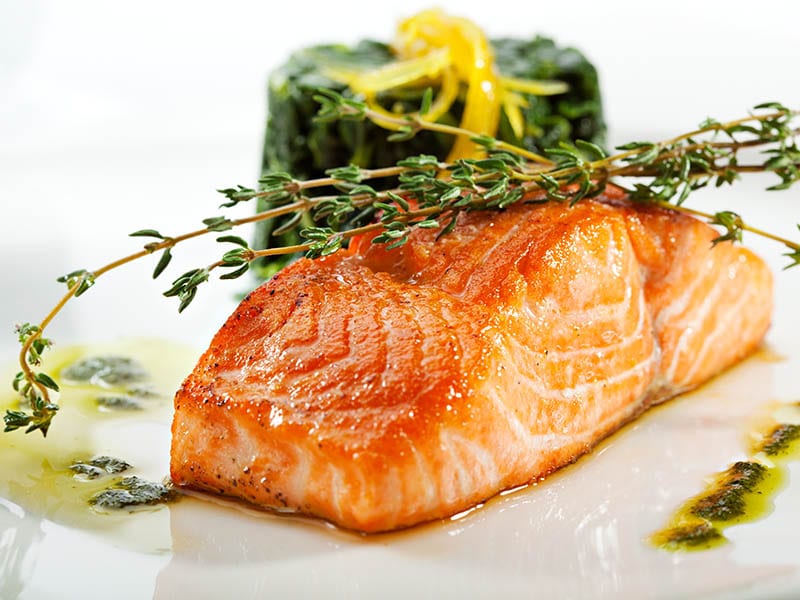
There are several signs that cooked salmon will show you. The biggest indication is how the meat separates along the white lines. Overcooked salmon will turn firm and hard. On the other hand, an undercooked one has translucent meat and glossy skin.
Properly cooked salmon boasts the flaky texture of cooked fish. You can use a fork to test the tenderness of the salmon.
You can also use the instant-read thermometer to check the internal temperature. As long as it stays around 140-150°F, your salmon is ready.
The last mark of perfectly cooked salmon is its color. As I mentioned earlier, undercooked salmon looks raw with its translucency. An overcooked one looks super dry with an orange color. A perfectly cooked filet of salmon has an opaque look.
The color of cooked salmon still depends on the type of salmon that you choose. They have a variety of colors, from pink to orange.
Here are some more indications that you can see in well-cooked salmon.
You Will Bake Salmon Better With These Handy Tips
There are still some problems here and there during your process of baking salmon. That’s why this section is here. I will give you some tips to help you ease the tasks and avoid all the potential accidents.
Check For Bones In Your Filet
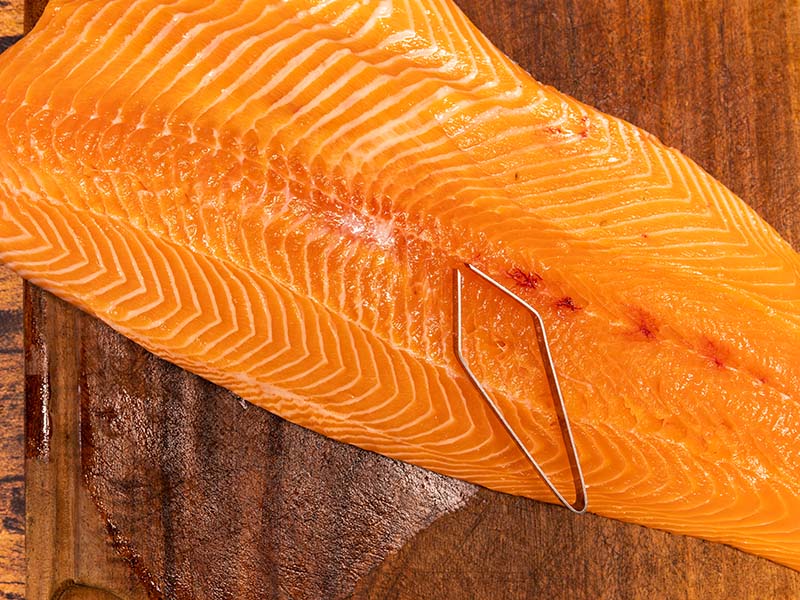
When you buy salmon filet from the market or the supermarket, don’t forget to ask the fishmonger if they have removed the pin bones for you or not. It is better to eliminate all of those annoying bones.
Pin bones in salmon look like long needles that stick along your filet. If you don’t have a fishmonger to ask, you can remove it by using a tweezer. It is dangerous to choke on salmon’s pin bones.
You can easily remove salmon pin bones with some simple steps.
Combine Your Favorite Spices With The Salmon
You can actually combine many flavors with your salmon, and they will all do their job to greatly complement the dish. If you are into a mixture of flavors, you can also combine these ingredients to mix their taste versatilely.
There are several groups of tastes that you can pair with your salmon. You don’t have to stick with rigid instructions or recipes. With baked salmon, you can allow your imagination to go as far as it can.
Choose Your Salmon
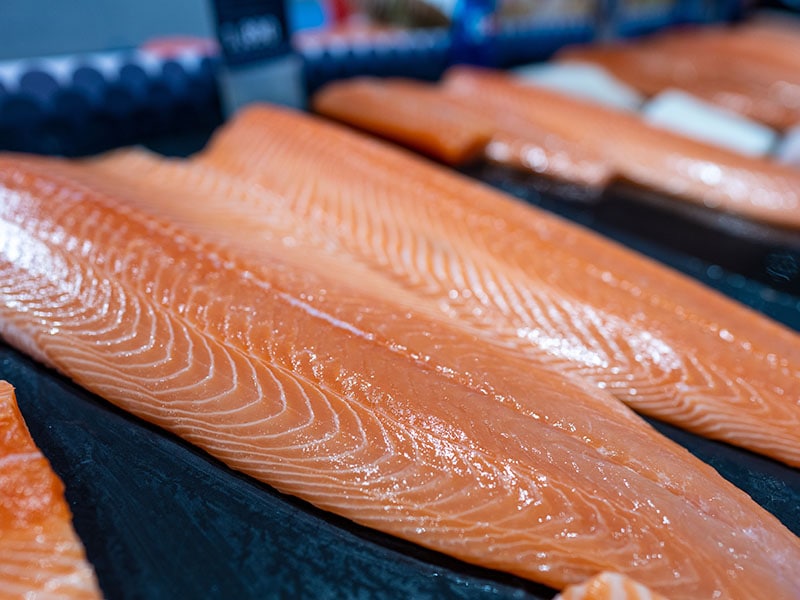
When you decide to choose salmon for your next meal, you will have to decide whether you want farmed salmon or wild salmon. Wild salmon has more nutrient contents while farmed salmon is cheaper. Both are great sources of omega-3.
There are six types of salmon that you can choose: King/Chinook, Sockeye/Red, Coho/Silver, Humpback/Pink, Chum/Silverbrite, and Atlantic/Salmo Salar. Each type has different tastes and colors, but they are all great salmon to bake.
Try Slow-Baking Your Salmon
Some people might be against this method since fish is not suitable for the slow-cook method. But slow-cook and slow-bake are not the same.
Slow-baking will gradually melt the salmon’s fat and allow the fat to render the meat part. Therefore, your salmon will be extremely luscious.
Slow-baking takes a little longer than regular baking: 40 minutes at 200°F. The recipe can be the same, or you can be creative and customize it depending on your desire for flavors.
Various Riveting Recipes To Customize Baked Salmon
Baked salmon is a classic dish, so people have upgraded and created many luscious recipes. Therefore, allow me to introduce you to some of the best recipes that I think you will enjoy as well.
Honey Garlic Baked Salmon With Soba Noodles
Just imagine marinating your salmon with honey, soy sauce, ginger, and garlic, and I promise that you will want to try this recipe. With the sweetness of honey and the saltiness of soy sauce, your salmon has reached another level of flavor.
Chipotle Lime Salmon
This recipe is a Mexican-style barbecue with your salmon as the protagonist. Chipotle chili’s spiciness and lime’s sourness will complement the fresh taste of salmon. With avocado salsa as a side dish to ease the heat, you definitely will not regret making this dish.
Classic Baked Salmon With Asparagus
So the classic of the classics has joined the chat. Baked salmon with asparagus around the globe. It is hard to find someone that can hate the tenderness of salmon filet and the crunchiness of asparagus.
If you think I overpraise this dish, you can follow the recipe and try the dish and see if you like it or not.
Baked salmon with asparagus can be easier to make with a lively step-by-step instruction.
Greek Salmon Salad
Nothing can give you more vitamin and fiber than a bowl of salad, but you also need protein. Don’t be worried! Salmon salad can be the solution for your search. It doesn’t contain too much fat and carbs, and you will not have to be skeptical about its marvelous taste.
FAQs
When you properly learn something new, you will start to develop questions around that topic. Therefore, I have answered some questions that you might think of. I’m going to give you a brief answer and an overview of what you are still curious about.
Now You Know How To Bake Salmon
I think at this point, you now can consider yourself a baked salmon expert. You have learned how to choose the salmon, how to bake the salmon at the best temperature, and what to avoid during the cooking procedure.
If you find this post very useful and informative, I suggest you share it with your friends and family. And let me know what you think in the comment section below. I would love to read your opinion and experience with baked salmon.
And it is time to say goodbye. See you soon!
Nutrition Facts
1 servings per container
- Amount Per ServingCalories370
- % Daily Value *
- Total Fat
25.6g
39%
- Saturated Fat 14.7g 70%
- Cholesterol 138mg 46%
- Sodium 1503mg 63%
- Potassium 695mg 20%
- Total Carbohydrate
9.9g
3%
- Dietary Fiber 1.4g 4%
- Sugars 7.7g
- Protein 30.9g 60%
- Calcium 81%
- Iron 3%
* The % Daily Value tells you how much a nutrient in a serving of food contributes to a daily diet. 2,000 calories a day is used for general nutrition advice.
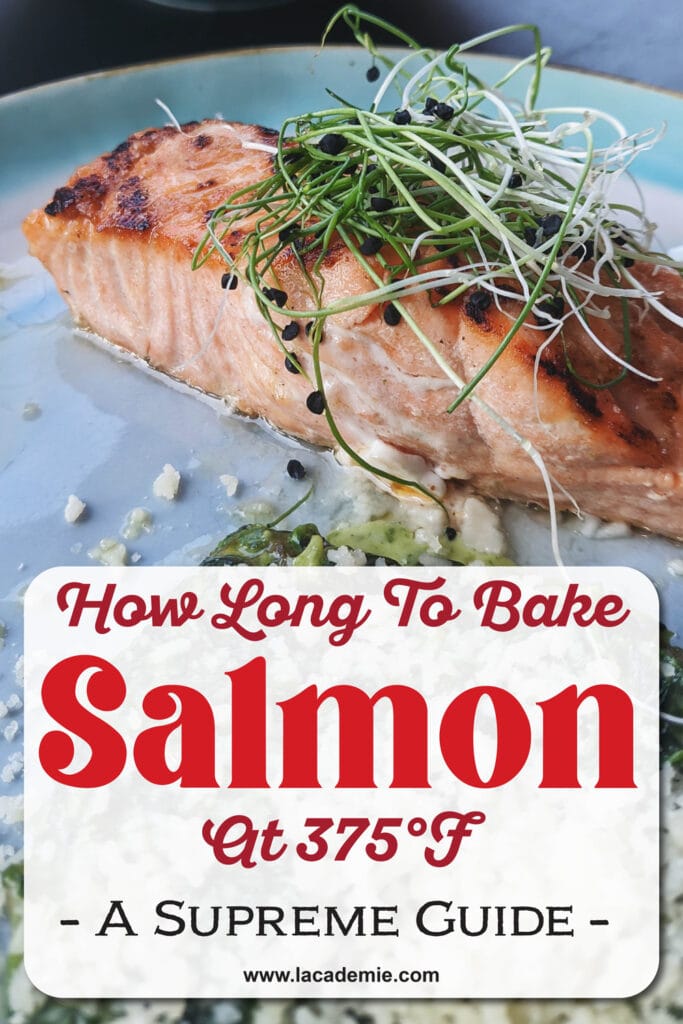
References
- Ware, M. and Butler, N., 2017. Salmon: Health benefits, facts, and research.
- Bhf.org.uk. 2022. Does cooking at high temperatures increase your risk of heart disease?.

